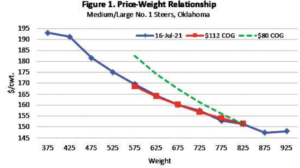As reported in FarmTalk. Rising feed prices continue to be reflected in feeder cattle markets. Market prices for feed grains increase in order to ration feed demand to balance with a limited supply. High feed prices is a market signal to all feed users to use less grain. For the pork and poultry industries this is a signal to reduce production, which is the only way monogastric animals can reduce feed use. For the cattle industry, high feed prices does not mean that less cattle will be fed and produced… certainly not for many months. The supply of feeder cattle adjusts only slowly with annual calf crops. High feed prices encourage the cattle industry to utilize the ruminant flexibility of cattle to change how cattle are fed.
Figure 1 shows the current average auction prices for Oklahoma feed cattle ranging from 375 pounds to 925 pounds (blue line). The set of feeder cattle prices at any point in time reflects a variety of factors including the overall supply of feeder cattle, fed cattle prices, feed and forage market conditions, time of year and other factors. The price level for big feeder cattle (right side of the graph) is mostly a function of expected fed cattle prices and the supply of big feeder cattle relative to feedlot production flows. Feedlots have flexibility to purchase and place cattle of varying weights in the feedlot. The cattle industry adjusts to high feed grain prices mostly by focusing on buying heavier feeder cattle that will require less feed to finish. Thus, high feed prices have relatively little impact on the price of big feeder cattle but a significant impact on the price of lighter weight feeder cattle relative to big feeders.
In Figure 1, the red line shows approximately how a feedlot is willing to price lighter weight feeder cattle relative to an 825-pound animal, in the current market, when feedlot cost of gain (COG) is $112/cwt. The red line lies on top of the blue market price line, which indicates that the feeder market currently reflects roughly this level of feed costs. The green line shows approximately how feedlots would price lighter weight feeder cattle if feedlot cost of gain was at 2020 levels, roughly $80/cwt. In other words, the price of lightweight feeder cattle would be significantly higher relative to heavy feeders with lower feed costs and the market line would be steeper and would be close to the green line.
This illustrates how the cattle industry responds to high feed grain prices and how the market adjustments coordinate the industry response outside of feedlots. The feeder cattle market responds to high feed prices by reducing the premium of lightweight feeders to heavy feeders as feedlot prefer to buy more pounds from the country. This represents a reduction in the price rollback or price slide for feeder cattle as weight increases. The result is to increase the value of gain for stocker production and thereby encourage cattle to achieve more weight prior to placement in the feedlot. More emphasis on stocker production also slows down the movement of cattle into the feedlot and reduces feed demand by spreading out feeder cattle over more time. The current value of gain for stocker production based on the market prices in Figure 1 is $1.05 to $1.10 per pound of gain for steers from 450 to 900 pounds.
High feed prices mostly impact how cattle are produced. In an environment of high feed prices the industry incentives are to make cattle bigger before feedlot placement and to slow down the rate of cattle production somewhat. For cow-calf and stocker producers, this means more opportunities for retained stockers and stocker production to heavier weights in response to those market signals.



